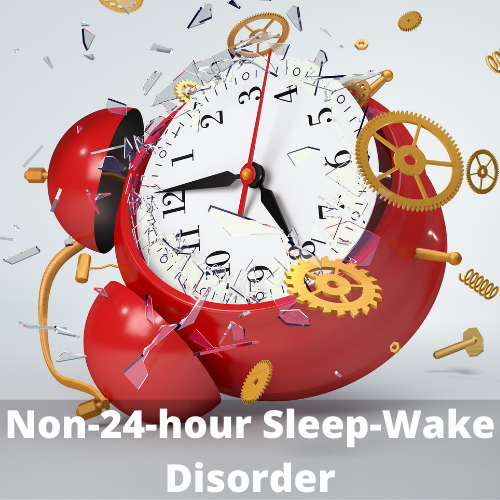Have you noticed that you don't go to sleep at the same time everyday, and that you seem to go to sleep later and later until you've hit a 24-hour sleep delay? This may sound confusing, but imagine one day you go to sleep at 10pm and then the next day at 11pm, and this continues until you find yourself going to sleep at 10pm again.
This is strange, and very abnormal, as our circadian rhythm actually helps us go to sleep at the same time everyday. If you are having trouble going to sleep everyday at the same time, then you may have non-24-hour sleep wake disorder (N24). Continue reading to find out more about it.
What is N24?
N24, or non-24-hour sleep-wake disorder is a sleep disorder that is an inability of your circadian rhythm to manage your sleep schedule. This means that your biological clock is essentially off. You don't have one or it is unable to manage your everyday schedule so you go to sleep at random times. You will go to sleep later and later by minutes or hours until you have completed the clock and made it back to the beginning.
Not only is your sleep impacted, but temperature and hormonal release is also on this same schedule, so attempting to fight it and force yourself to go to sleep at the same time everyday can actually result in severe sleep deprivation. N24 occurs mostly in blind individuals, but can also occur in those with sight.
Signs and symptoms of N24
A common sign, or potentially the first sign that is noticed, is random bouts of insomnia followed by excessive daytime sleepiness. Insomnia is the inability to go to sleep, and excessive daytime sleepiness is feeling incredibly tired during the day, especially while exposed to light which should delay the onset of melatonin and any other sleep inducing feelings.
These waves will be cyclical so there are moments when you feel normal because your clock is aligned with societies, but then there are times when your clock is the opposite and that's when you struggle or feel the symptoms themost. Most individuals have a 24-hour clock, but some even have a 28- or 30-hour clock, further exacerbating the symptoms.
When allowed to sleep according to your schedule, you may feel relief from these moments of insomnia and fatigue, but at the expense of not being able to keep a daily schedule. But, some will continue to feel these symptoms, even if they try to adhere to their own personal schedule just because of the desynchronization of their clock.
Without any sort of management, and an attempt to stay on a 24-hour clock, these individuals are at extreme risk for the accumulation of their symptoms including daytime sleepiness, fatigue, depression and difficulty concentration or memory problems. Isolation and loneliness are also secondary symptoms due to the clock causing these individuals to be awake when others are asleep.
Causes
In the brain, there is a region in the hypothalamus called the suprachiasmatic nucleus (SCN). The SCN is responsible for maintaining the sleep-wake pattern of the entire body, including influencing the production of melatonin and orexin (two hormones responsible for sleep and wake respectively), body temperatures (peak at morning, and low at night), and is heavily influenced by light receiving molecules in the eye.
When this process is interrupted, then the body can no longer maintain its circadian rhythm, and the SCN goes a little rogue. Factors that can interrupt this process include:
- blindness - no perception of light which means the SCN doesn't have that extra system to keep it in check, leading to a gradual drifting of the 24-hour cycle.
- alteration in light sensitivity - dampened perceptions of light which to an inability to truly influence the circadian rhythm.
- environment - isolation with total control of when to turn lights on and off will not receive natural cues.
- hormonal - a lack of melatonin may lead to the development or perpetuation of N23 which can lead to an inability to regulate the sleep-wake cycle.
Diagnosis
The initial diagnosis is based on sleep logs by the patient that show a non-24-hour sleep pattern. It's more easily distinguished if the patient's sleep times are not constrained by social or occupational obligations.
Confirmation of the diagnosis may be done by wearing an actigraphy which is a device worn on the wrist that tracks the timing of sleep. It should be worn for sufficient time for the sleep cycle to complete one pass around the clock, typically taking several weeks.
A polysomnography is not necessary for diagnosis, so this is very much a disorder reliant on the patient's own log of what's happening.
Therapy
The mostly widely recommended treatment for sighted patients is exposure to specific regimens of light and dark therapy. A lightbox is useful for phototherapy (light) and is used early in the morning, typically for a duration of 2 hours to stabilize the sleep cycle.
Dark therapy is accomplished by avoiding light exposure late in the day by staying in a dark room or by using special goggles that reduce the amount of light that is allowed in.
For blind individuals, melatonin therapy is the most recommended, although there are investigational therapies looking at other supplements and their impact on circadian rhythm.
[Source]:
https://rarediseases.org/rare-diseases/non-24-hour-sleep-wake-disorder/


